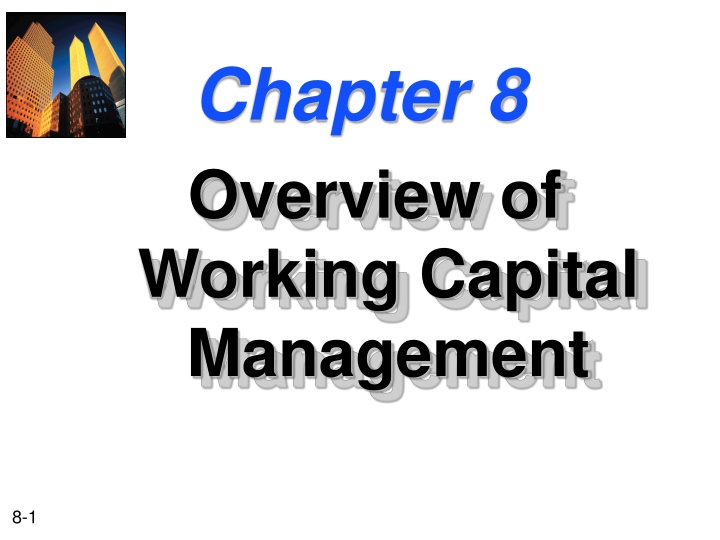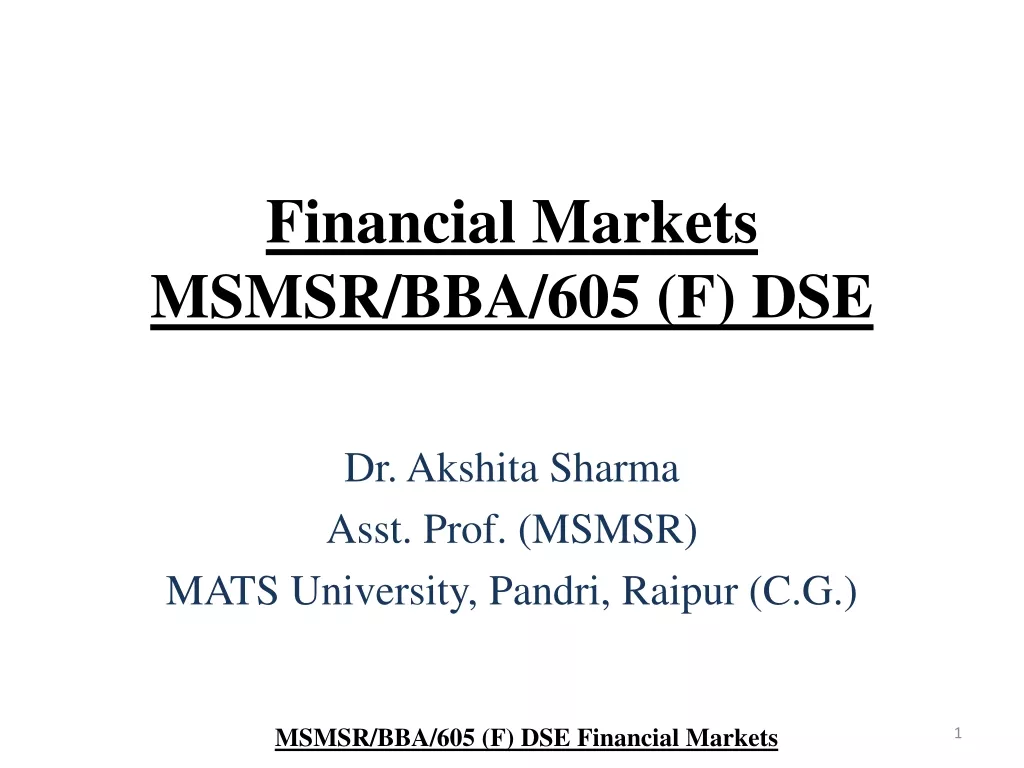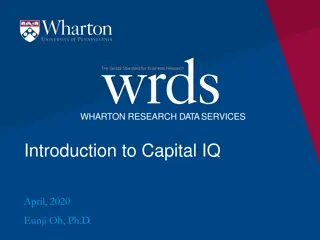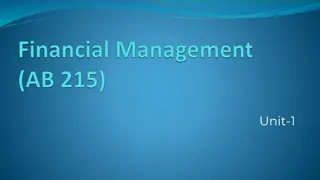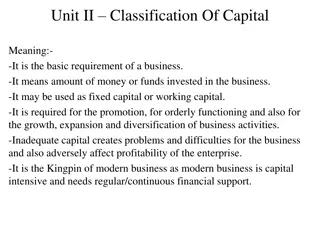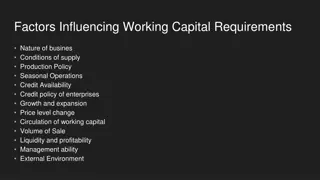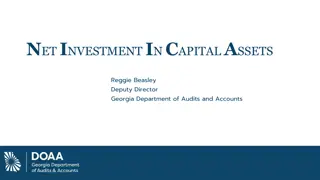Overview of Working Capital Management in Financial Management
Working capital management involves strategic decision-making regarding a company's current assets and liabilities to optimize liquidity, profitability, and risk. This process includes understanding working capital concepts, financing current assets, managing liability structure, and maintaining the right balance between short-term and long-term assets. Effective working capital management is crucial for ensuring efficient operations, minimizing risks, and enhancing financial performance in businesses.
Download Presentation

Please find below an Image/Link to download the presentation.
The content on the website is provided AS IS for your information and personal use only. It may not be sold, licensed, or shared on other websites without obtaining consent from the author.If you encounter any issues during the download, it is possible that the publisher has removed the file from their server.
You are allowed to download the files provided on this website for personal or commercial use, subject to the condition that they are used lawfully. All files are the property of their respective owners.
The content on the website is provided AS IS for your information and personal use only. It may not be sold, licensed, or shared on other websites without obtaining consent from the author.
E N D
Presentation Transcript
Chapter 8 Overview of Working Capital Management 8-1
Overview of Working Capital Management Working Capital Concepts Working Capital Issues Financing Current Assets: Short-Term and Long-Term Mix Combining Liability Structure and Current Asset Decisions 8-2
Working Capital Concepts Net Working Capital (Accounting POV) Current Assets - Current Liabilities. Gross Working Capital (FM POV) The firm s investment in current assets. Working Capital Management The administration of the firm s current assets and the financing needed to support current assets. 8-3
Significance of Working Capital Management In a typical manufacturing firm, current assets exceed one-half of total assets. Excessive levels can result in a substandard Return on Investment (ROI). Current liabilities are the principal source of external financing for small firms. Requires continuous, day-to-day managerial supervision. Working capital management affects the company s risk, return, and share price. 8-4
Working Capital Issues Optimal Amount (Level) of Current Assets Assumptions 50,000 maximum units of production Continuous production Three different policies for current asset levels are possible Policy A ASSET LEVEL ($) Policy B Policy C Current Assets 0 25,000 50,000 OUTPUT (units) 8-5
Impact on Liquidity Optimal Amount (Level) of Current Assets Liquidity Analysis Policy A B C Greater current asset levels generate more liquidity; all other factors held constant. Policy A Liquidity High Average Low ASSET LEVEL ($) Policy B Policy C Current Assets 0 25,000 50,000 OUTPUT (units) 8-6
Impact on Expected Profitability Optimal Amount (Level) of Current Assets Return on Investment = Policy A Net Profit Total Assets ASSET LEVEL ($) Policy B Let Current Assets = (Cash + Rec. + Inv.) Policy C Current Assets Return on Investment = Net Profit Current + Fixed Assets 0 25,000 50,000 OUTPUT (units) 8-7
Impact on Expected Profitability Optimal Amount (Level) of Current Assets Profitability Analysis Policy Profitability A B C Policy A ASSET LEVEL ($) Policy B Low Average High Policy C Current Assets As current asset levels decline, total assets will decline and the ROI will rise. 0 25,000 50,000 OUTPUT (units) 8-8
Impact on Risk Optimal Amount (Level) of Current Assets Decreasing cash reduces the firm s ability to meet its financial obligations. More risk! Stricter credit policies reduce receivables and possibly lose sales and customers. More risk! Lower inventory levels increase stockouts and lost sales. More risk! Policy A ASSET LEVEL ($) Policy B Policy C Current Assets 0 25,000 50,000 OUTPUT (units) 8-9
Impact on Risk Optimal Amount (Level) of Current Assets Risk Analysis Policy A B C Policy A Risk Low Average High ASSET LEVEL ($) Policy B Policy C Current Assets Risk increases as the level of current assets are reduced. 0 25,000 50,000 OUTPUT (units) 8-10
Summary of the Optimal Amount of Current Assets SUMMARY OF OPTIMAL CURRENT ASSET ANALYSIS Policy Liquidity Profitability Risk A High Low B Average Average C Low High Low Average High 1. Profitability varies inversely with liquidity. 2. Profitability moves together with risk. (risk and return go hand in hand!) 8-11
Classifications of Working Capital Components Cash, marketable securities, receivables, and inventory Time Permanent Temporary 8-12
Permanent Working Capital The amount of current assets required to meet a firm s long-term minimum needs. DOLLAR AMOUNT Permanent current assets TIME 8-13
Permanent Working Capital It does not consist of particular current assets staying permanently in place, but is a permanent level of investment in current assets, whose individual items are constantly turning over. E.g. Payments, Salary, Minimum Stock of materials, Electricity and Telephone Bills. 8-14
Temporary Working Capital The amount of current assets that varies with seasonal requirements. Temporary current assets DOLLAR AMOUNT Permanent current assets TIME 8-15
Financing Current Assets: Short-Term and Long-Term Mix Spontaneous Financing: Trade credit, and other payables and accruals, that arise spontaneously in the firm s day-to-day operations. Based on policies regarding payment for purchases, labor, taxes, and other expenses. We are concerned with managing non- spontaneous financing of assets. 8-16
Hedging (or Maturity Matching) Approach A method of financing where each asset would be offset with a financing instrument of the same approximate maturity. Short-term financing** DOLLAR AMOUNT Current assets* Long-term financing Fixed assets TIME 8-17
Hedging (or Maturity Matching) Approach * Less amount financed spontaneously by payables and accruals. ** In addition to spontaneous financing (payables and accruals). Short-term financing** DOLLAR AMOUNT Current assets* Long-term financing Fixed assets TIME 8-18
Financing Needs and the Hedging Approach Fixed assets and the non-seasonal portion of current assets are financed with long- term debt and equity (long-term profitability of assets to cover the long-term financing costs of the firm). Seasonal needs are financed with short- term loans (under normal operations sufficient cash flow is expected to cover the short-term financing cost). 8-19
Self-Liquidating Nature of Short-Term Loans Seasonal orders require the purchase of inventory beyond current levels. Increased inventory is used to meet the increased demand for the final product. Sales become receivables. Receivables are collected and become cash. The resulting cash funds can be used to pay off the seasonal short-term loan and cover associated long-term financing costs. Short-term, inherently self-liquidating loans, referred to as STISL. 8-20
Risks vs. Costs Trade-Off (Conservative Approach) Long-Term Financing Benefits Less worry in refinancing short-term obligations Less uncertainty regarding future interest costs Short-Term Financing Risks Borrowing more than what is necessary Borrowing at a higher overall cost (usually) Result Manager accepts less expected profits in exchange for taking less risk. 8-21
Risks vs. Costs Trade-Off (Conservative Approach) Firm can reduce risks associated with short-term borrowing by using a larger proportion of long-term financing. Short-term financing DOLLAR AMOUNT Current assets Long-term financing Fixed assets TIME 8-22
Comparison with an Aggressive Approach Short-Term Financing Benefits Financing long-term needs with a lower interest cost than short-term debt Borrowing only what is necessary Short-Term Financing Risks Refinancing short-term obligations in the future Uncertain future interest costs Result Manager accepts greater expected profits in exchange for taking greater risk. 8-23
Risks vs. Costs Trade-Off (Aggressive Approach) Firm increases risks associated with short-term borrowing by using a larger proportion of short-term financing. Short-term financing DOLLAR AMOUNT Current assets Long-term financing Fixed assets TIME 8-24
Summary of Short- vs. Long-Term Financing Financing Maturity Asset Maturity SHORT-TERM LONG-TERM SHORT-TERM (Temporary) Moderate Risk-Profitability Low Risk-Profitability High LONG-TERM (Permanent) Moderate Risk-Profitability Risk-Profitability 8-25
Combining Liability Structure and Current Asset Decisions The level of current assets and the method of financing those assets are interdependent. A conservative policy of high levels of current assets allows a more aggressive method of financing current assets. A conservative method of financing (all-equity) allows an aggressive policy of low levels of current assets. 8-26
